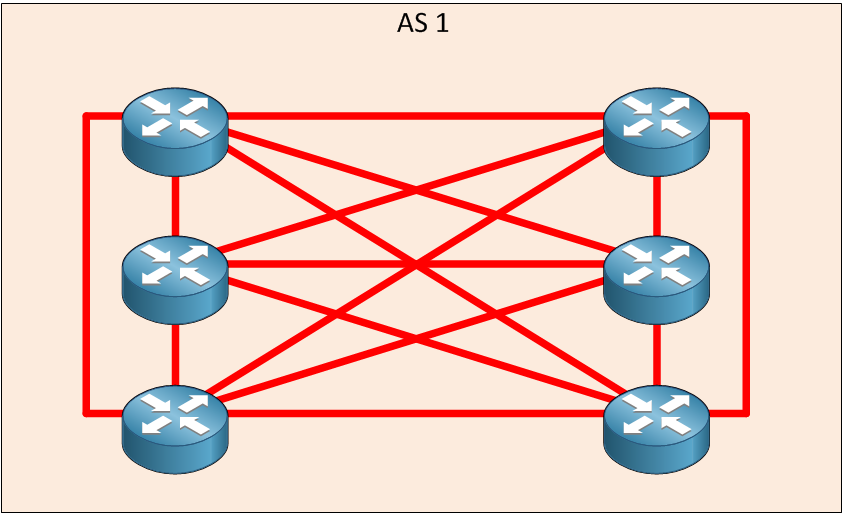Lesson Contents
In this lesson, we’ll take a look at the BGP Confederation. As you might know, IBGP requires a full mesh of peerings which can become an administrative nightmare. If you don’t know why we need a full mesh, I recommend to start reading my IBGP lesson first.
To reduce the number of IBGP peerings, there are two techniques:
Let’s talk about confederations, look at the picture below:

Above, we have AS 1 with six routers running IBGP. The number of IBGP peerings can be calculated with the full mesh formula:
N(N-1)/2
So, in our case, that’s:
6 * (6-1 = 5) / 2 = 15 IBGP peerings.
A BGP confederation divides our AS into sub-ASes to reduce the number of required IBGP peerings. Within a sub-AS, we still require full-mesh IBGP but between these sub-ASes we use something that looks like EBGP but behaves like IBGP (called confederation BGP) . Here’s an example of what a BGP confederation could look like:

By dividing our main AS into two sub-ASes, we reduced the number of IBGP peerings from 15 to 8.
Within the sub-AS, we still have the full-mesh IBGP requirement. Between sub-ASes, it’s just like EBGP, it’s up to you how many peerings you want. The outside world will never see your sub-AS numbers. They will only see the main AS number.
Since the sub-AS numbers are not seen outside of your network, you will often see private AS numbers used for the sub-ASes (64512 – 65535), but you can pick any number you like.
Configuration
You should now have an idea of what BGP confederations are like, let’s look at the configuration so I can add some more details. I’ll use the following topology:

Above we have AS 2 which is divided into two sub-ASes, AS 24 and AS 35. There’s also AS 1 on top that we can use to see how the outside world sees our confederation.
Just like any other IBGP configuration, it’s best practice to use loopback interfaces for the BGP sessions. For this reason, I created a loopback interface on all routers within AS 2, and I’ll use OSPF to advertise them.
OSPF Configuration
R2(config)#router ospf 1
R2(config-router)#network 192.168.23.0 0.0.0.255 area 0
R2(config-router)#network 192.168.24.0 0.0.0.255 area 0
R2(config-router)#network 2.2.2.2 0.0.0.0 area 0R3(config)#router ospf 1
R3(config-router)#network 192.168.23.0 0.0.0.255 area 0
R3(config-router)#network 192.168.35.0 0.0.0.255 area 0
R3(config-router)#network 3.3.3.3 0.0.0.0 area 0R4(config)#router ospf 1
R4(config-router)#network 192.168.24.0 0.0.0.255 area 0
R4(config-router)#network 192.168.45.0 0.0.0.255 area 0
R4(config-router)#network 4.4.4.4 0.0.0.0 area 0R5(config)#router ospf 1
R5(config-router)#network 192.168.35.0 0.0.0.255 area 0
R5(config-router)#network 192.168.45.0 0.0.0.255 area 0
R5(config-router)#network 5.5.5.5 0.0.0.0 area 0Now, we can worry about the BGP confederation configuration. I’ll explain all the different steps…
BGP Confederation Configuration
Let’s start with R2:
R2(config)#router bgp 24
R2(config-router)#bgp confederation identifier 2
R2(config-router)#bgp confederation peers 35
R2(config-router)#neighbor 4.4.4.4 remote-as 24
R2(config-router)#neighbor 4.4.4.4 update-source loopback 0
R2(config-router)#neighbor 3.3.3.3 remote-as 35
R2(config-router)#neighbor 3.3.3.3 update-source loopback 0
R2(config-router)#neighbor 3.3.3.3 ebgp-multihop 2The configuration of R2 requires some explanation. First of all, when you start the BGP process, you have to use the AS number of the sub-AS. Secondly, you have to use the bgp confederation identifier command to tell BGP what the main AS number is.
We also have to configure all other sub-AS numbers with the bgp confederation peers command, in this case, that’s only AS 35. R4 is in the same sub-as, so you can configure this neighbor just like any other IBGP neighbor. R3 is a bit different, though…since it’s in another sub-AS, we have to use the same rules as EBGP, which means configuring multihop if you are using loopbacks.
Let’s take a look at R3:
R3(config)#router bgp 35
R3(config-router)#bgp confederation identifier 2
R3(config-router)#bgp confederation peers 24
R3(config-router)#neighbor 2.2.2.2 remote-as 24
R3(config-router)#neighbor 2.2.2.2 update-source loopback 0
R3(config-router)#neighbor 2.2.2.2 ebgp-multihop 2
R3(config-router)#neighbor 5.5.5.5 remote-as 35
R3(config-router)#neighbor 5.5.5.5 update-source loopback 0The configuration of R3 is similar to R2. We configure it to use AS 35 while the main AS is 2. Our only sub-AS peer is 24, and we have two neighbors…one IBGP neighbor and one “EBGP” (confederation BGP) neighbor.
R4 and R5 look pretty much the same:
R4(config)#router bgp 24
R4(config-router)#bgp confederation identifier 2
R4(config-router)#bgp confederation peers 35
R4(config-router)#neighbor 2.2.2.2 remote-as 24
R4(config-router)#neighbor 2.2.2.2 update-source loopback 0
R4(config-router)#neighbor 5.5.5.5 remote-as 35
R4(config-router)#neighbor 5.5.5.5 update-source loopback 0
R4(config-router)#neighbor 5.5.5.5 ebgp-multihop 2R5(config)#router bgp 35
R5(config-router)#bgp confederation identifier 2
R5(config-router)#bgp confederation peers 24
R5(config-router)#neighbor 4.4.4.4 remote-as 24
R5(config-router)#neighbor 4.4.4.4 update-source loopback 0
R5(config-router)#neighbor 4.4.4.4 ebgp-multihop 2
R5(config-router)#neighbor 3.3.3.3 remote-as 35
R5(config-router)#neighbor 3.3.3.3 update-source loopback 0That takes care of configuring the neighbors. The more interesting part is, of course, using some show commands to see the differences between normal IBGP and EBGP. Let’s get going…
Verification
To have something we can look at, I will create a loopback interface on R5 and advertise a network in BGP:
R5(config)#interface loopback 5
R5(config-if)#ip address 55.55.55.55 255.255.255.255Let’s advertise it in BGP:
R5(config)#router bgp 35
R5(config-router)#network 55.55.55.55 mask 255.255.255.255Let’s look at R3 first. This router is in the same sub-AS as R5:
R3#show ip bgp 55.55.55.55
BGP routing table entry for 55.55.55.55/32, version 2
Paths: (1 available, best #1, table Default-IP-Routing-Table)
Flag: 0x820
Advertised to update-groups:
2
Local
5.5.5.5 (metric 2) from 5.5.5.5 (5.5.5.5)
Origin IGP, metric 0, localpref 100, valid, confed-internal, bestThis entry looks pretty much the same as normal IBGP, but there’s one important difference…



Awesome work !!!
Well Done man. I was reading the same topic on the TCP/IP Vol II but the topology used there was quite confusing. Here you used a simple topology and explained to concept of it in a nice and clean way.
Hi Mauro,
Glad to hear it was useful to you, I did my best to keep it as simple as possible.
Rene
Great job Rene… This cant get any simpler than this.. Finally I learned confederation.. Was not able to answer this in so many interview..Now I’m confident
Glad to hear that Abhishek